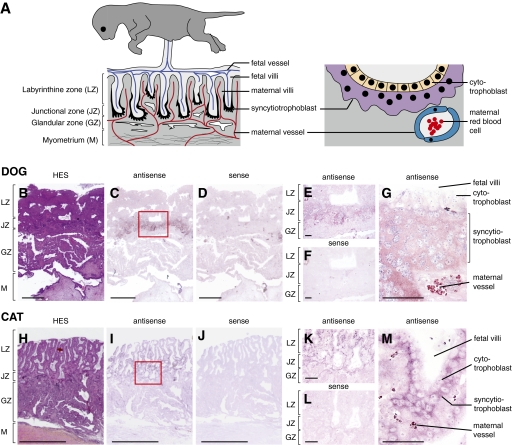Fig. 8.
Structure of the Carnivora placenta and in situ hybridization for syncytin-Car1 expression on dog and cat placental sections. (A) Schematic representation of the Carnivora placenta (A Left) with, from mother to fetus, the myometrium (M), the glandular zone (GZ), the junctional zone (JZ), and the labyrinthine zone (LZ). The maternal and fetal vessels are schematized, with the invasive syncytiotrophoblast at the fetomaternal interface colored in black at the tip of the invading fetal villi. An enlarged view (A Right) shows the multinucleated syncytiotrophoblast (purple) generated by fusion from the underlying mononucleated cytotrophoblast cells (yellow) forming the interface between the fetal compartments and the maternal vessels (with the red blood cells schematized). Sections of placenta from dog (B–G) and cat (H–M) at midgestation. (B and H) Hematoxylin–eosin–saffron staining (HES) of the placental section with the four layers indicated. (C–G and I–M) In situ hybridization on serial sections observed at different magnifications using digoxigenin-labeled antisense (C, E, G, I, K, and M) or sense (negative control; D, F, J, and L) riboprobes revealed with an alkaline phosphatase-conjugated antidigoxigenin antibody. (E, F, K, and L) Intermediate magnification of the junctional domain delineated in C and I (red boxed areas). (G and M) Higher magnification with the fetal villi, the labeled syncytiotrophoblast, and the maternal vessels clearly visible. (Scale bars: B–D and H–J, 1 mm; E, F, K, and L, 100 μm; G and M, 50 μm.)

